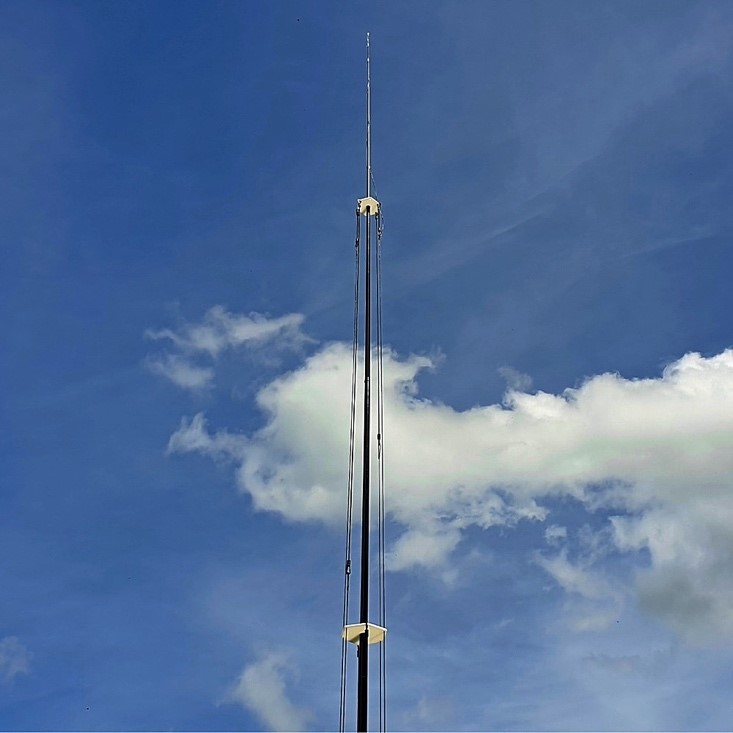It’s good to have choices. DX Commander has six multiband verticals that can be used in a variety of applications, from HF permanent installations to portable deployments. We recently reviewed the DX Commander Classic, a good candidate for base stations and multipurpose use.
This review examines the DX Commander Rapide HF Multiband Vertical, a low-profile six-band antenna perfect for POTA, SOTA, Field Day, emergency use, and HOA installations.

All in the Family
Like other DX Commander antennas, the Rapide uses a fiberglass telescopic mast (22.97 feet). Metal and milled plastic parts help support the antenna elements, which are spaced around the mast. All antenna elements are essentially quarter-wave or 5/8th-wave verticals coupled to a central feedpoint. They’re kept snug with shock cord attached through several support plates.
Based on the same principles as the DX Commander Classic, the Rapide delivers exactly the same results with quarter-wave elements on 30m, 20m, 17m, 15m, 12m, and 10m. The 6m band uses the 30m wire as a 1 1/4 wavelength element. Forty meters can be added, but more on that later. After testing and tuning, the resonant point on all bands was 1.5:1 or less, with 20m at 1.02:1—not bad for the poor ground conditions in the Mojave Desert.
The build is similar to the original Classic, and the Rapide takes roughly the same amount of time to complete. Since the Rapide uses only 25m of wire for the elements, it leaves 75m of wire for the radials. Based on his field tests, developer Callum McCormick, M0MCX, suggests 20 radials, 10.5 feet long for this antenna. This doesn’t exactly coincide with traditional thinking, but McCormick believes more wire on the ground is preferable to having specific lengths—like quarter-wave radials for each band.
Choices, Choices
Flexibility is the Rapide’s middle name. If you want CB bands and not 12m, trim the 12m element a bit shorter and you have 11m CB at your fingertips. Alternatively, cut the 30m element longer for a 5/8 wave on 10m and with the spare slot, cut an 11m element. You still want the 40m band? Do this by making a loading coil halfway between the base and the first spreader or by extending the 30m element—details are in the user guide.
Actually, you could add 80m as well. What I did in my installation was to lengthen the 30m element to be resonant on 40m. Next, I installed a 40m trap at the end of the new 40m wire and added about 25 feet of additional wire for 80m, running it horizontally to a fiberglass pole—instant 40/80m coverage. Your results may vary based on the trap used, bandwidth preferences, and your antenna site.
You don’t have to run multiple bands. For quicker setups, users may choose to run fewer elements, say 30m, 20m and 17m, or any other combination you want. You can even make it a monoband vertical. Just be sure to add some tension to the opposite side of the plastic spreaders to balance the downward pull.
Resources
This antenna is great for those who want to get some hands-on experience with building and tuning antennas. Numerous videos on building this antenna are available, including those by DX Commander. Others describe helpful tips and accessories you can make yourself, such as a simple base for permanent mounting and making band additions.
The Rapide manual can be found here. You’ll find updates and tips at the DX Commander website.
How it Plays
The DX Commander vertical works the same way a fan dipole works. Depending on what band you’re transmitting, the RF you’re sending ignores the non-resonant elements and uses the resonant ones automatically. Without going into a lot of technical stuff, the RF will seek out the element(s) that present a 50-ohm load (+/-) to the transmitter. So if you’re transmitting on 20m, the 20m element on the antenna will radiate signal, but the others won’t.
A good radial system is important for best performance, especially at my test site in Arizona. Remember that radials are the other half of the antenna—think dipole. The number and length of radials used will also affect tuning. Aim for more, shorter radials rather than fewer, longer ones.
I already had ten radials in the ground that were used for another vertical I’d installed earlier. Varying lengths were used to fit the available area. I estimate there is more than 300 feet of wire buried in the dry soil, surrounded by mountains. It’s not the optimum set of conditions for ham operations, but you work with what you’ve got.
In this hot environment, the nylon clamps and marine heat shrink came in handy. Electrical tape wouldn’t hold for more than a day, for either the pole joints or fold-overs. More stable alternatives are necessary to keep the pole and antenna wires from slip-sliding away.
Turning on the radio, I found an opening on 10m. I decided to call a German station that had a relatively loud signal. We exchanged 57 reports and the next call was to a station in Wisconsin, 59 reports both ways. Later contacts on 40 and 80 meters verified the modification I made was working properly. Success with only 100W PEP!
Final Impressions
The DX Commander Rapide HF Vertical Antenna is lightweight, solid, and covers the bands specified. The 1/4 and 5/8 wire elements allow most to be dedicated to a single band, thus maximizing performance. It’s particularly suited for portable operations and HOA installations due to its reduced height.
The vertical antenna is reasonably priced for what you get. Since it has been around for a few years, there’s plenty of support in the form of YouTube videos, online groups, and the Rapide’s creator himself.

